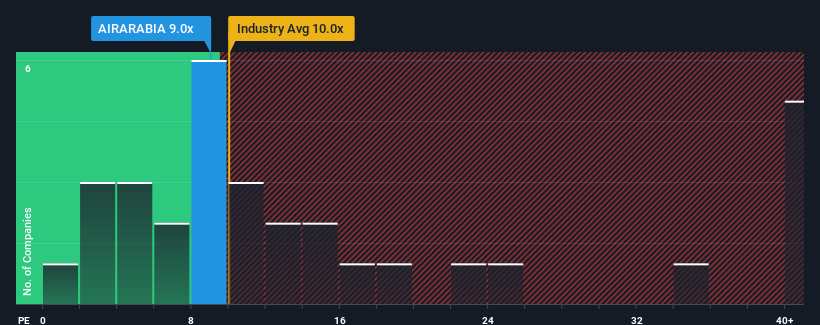- United Arab Emirates
- /
- Airlines
- /
- DFM:AIRARABIA
Not Many Are Piling Into Air Arabia PJSC (DFM:AIRARABIA) Just Yet

Air Arabia PJSC's (DFM:AIRARABIA) price-to-earnings (or "P/E") ratio of 9x might make it look like a buy right now compared to the market in the United Arab Emirates, where around half of the companies have P/E ratios above 14x and even P/E's above 22x are quite common. Although, it's not wise to just take the P/E at face value as there may be an explanation why it's limited.
While the market has experienced earnings growth lately, Air Arabia PJSC's earnings have gone into reverse gear, which is not great. The P/E is probably low because investors think this poor earnings performance isn't going to get any better. If this is the case, then existing shareholders will probably struggle to get excited about the future direction of the share price.
View our latest analysis for Air Arabia PJSC

Is There Any Growth For Air Arabia PJSC?
Air Arabia PJSC's P/E ratio would be typical for a company that's only expected to deliver limited growth, and importantly, perform worse than the market.
If we review the last year of earnings, dishearteningly the company's profits fell to the tune of 12%. Still, the latest three year period has seen an excellent 6,596% overall rise in EPS, in spite of its unsatisfying short-term performance. So we can start by confirming that the company has generally done a very good job of growing earnings over that time, even though it had some hiccups along the way.
Shifting to the future, estimates from the six analysts covering the company suggest earnings should grow by 3.9% per year over the next three years. That's shaping up to be similar to the 4.3% per annum growth forecast for the broader market.
With this information, we find it odd that Air Arabia PJSC is trading at a P/E lower than the market. It may be that most investors are not convinced the company can achieve future growth expectations.
The Final Word
Using the price-to-earnings ratio alone to determine if you should sell your stock isn't sensible, however it can be a practical guide to the company's future prospects.
We've established that Air Arabia PJSC currently trades on a lower than expected P/E since its forecast growth is in line with the wider market. There could be some unobserved threats to earnings preventing the P/E ratio from matching the outlook. It appears some are indeed anticipating earnings instability, because these conditions should normally provide more support to the share price.
It is also worth noting that we have found 2 warning signs for Air Arabia PJSC (1 is potentially serious!) that you need to take into consideration.
If P/E ratios interest you, you may wish to see this free collection of other companies with strong earnings growth and low P/E ratios.
New: Manage All Your Stock Portfolios in One Place
We've created the ultimate portfolio companion for stock investors, and it's free.
• Connect an unlimited number of Portfolios and see your total in one currency
• Be alerted to new Warning Signs or Risks via email or mobile
• Track the Fair Value of your stocks
Have feedback on this article? Concerned about the content? Get in touch with us directly. Alternatively, email editorial-team (at) simplywallst.com.
This article by Simply Wall St is general in nature. We provide commentary based on historical data and analyst forecasts only using an unbiased methodology and our articles are not intended to be financial advice. It does not constitute a recommendation to buy or sell any stock, and does not take account of your objectives, or your financial situation. We aim to bring you long-term focused analysis driven by fundamental data. Note that our analysis may not factor in the latest price-sensitive company announcements or qualitative material. Simply Wall St has no position in any stocks mentioned.
About DFM:AIRARABIA
Flawless balance sheet established dividend payer.
Similar Companies
Market Insights
Community Narratives




